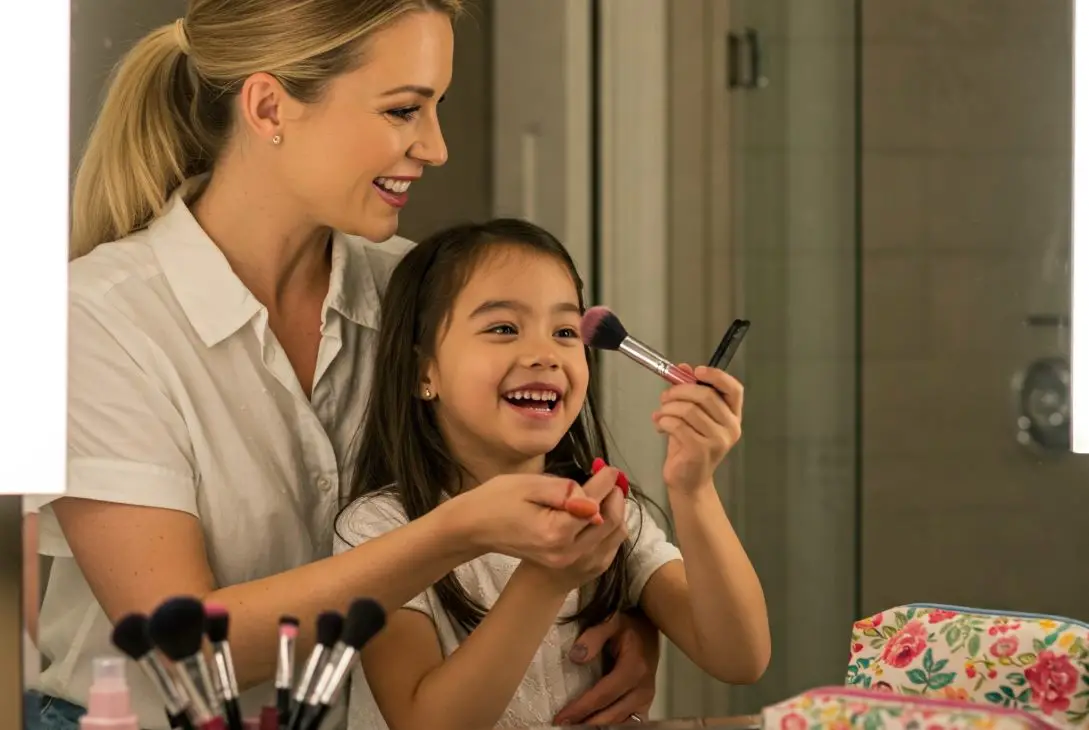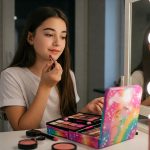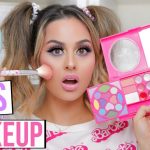How To Do Makeup For Kids Step by Step At Home
Kids love to play dress-up, and makeup is often a delightful part of that imaginative world. Whether it’s for a themed birthday party, a school play, or just a fun afternoon at home, learning how to do makeup for kids safely and creatively is a valuable skill.
In this guide, i will walk you through the process step-by-step, ensuring a fun and safe experience for everyone.
Why Kids Love To Makeup:
Before we go into the full details, let’s understand why kids are drawn to makeup:
- Creative Expression: Makeup allows kids to explore different characters and express their creativity visually.
- Imaginative Play: It enhances role-playing and storytelling, bringing their fantasies to life.
- Self-Exploration: It’s a way for kids to experiment with different looks and discover their own style.
- Fun and Bonding: Applying makeup can be a fun activity to share with friends or family.
How To Choose The Right Products:
Kid’s skin is delicate, so safety is very important. Here’s how to choose kid-friendly makeup:
- Hypoallergenic and Non-Toxic: Look for products specifically designed for children, labelled “hypoallergenic,” “non-toxic,” and “paraben-free.”
- Water-Based Makeup: Water-based makeup is easier to remove and gentler on the skin.
- Avoid Adult Makeup: Adult makeup often contains harsh chemicals and fragrances that can irritate a child’s skin.
- Check for Allergies: Perform a patch test on a small area of skin before applying makeup to the face.
- FDA Approved: When possible, ensure the products are FDA approved.
- Read the Ingredients: Become familiar with common irritants and avoid them.
Essential Tools and Supplies For Kid Makeup:
- Makeup Brushes: A set of soft, kid-friendly brushes in various sizes.
- Makeup Sponges: For applying foundation or blending cream makeup.
- Water-Based Face Paint: For creative designs and themed looks.
- Kid-Friendly Makeup Palettes: Featuring a range of safe colors.
- Gentle Cleanser: For removing makeup thoroughly.
- Moisturizer: To hydrate the skin before and after makeup application.
- Hair Accessories: For completing the look.
- Baby Wipes: For quick cleanups.
- Mirror: For your child to see the progress.
- Headband: To keep hair away from the face.
Step-by-Step Makeup Application:
-
Prepare the Skin:
- Start with a clean face. Gently wash the child’s face with a mild cleanser and pat it dry.
- Apply a light, hypoallergenic moisturizer to hydrate the skin. This creates a smooth canvas for makeup application.
-
Base Makeup (Optional):
- For a more polished look, you can apply a light layer of water-based foundation or tinted moisturizer.
- Use a makeup sponge or your fingers to apply the product evenly.
- If using face paint as a base, ensure it is completely dry before adding other colors.
- If using face paint as a base, ensure it is a light layer.
-
Eye Makeup:
- Eyeshadow: Choose soft, pastel colors or vibrant shades depending on the desired look. Apply eyeshadow with a small, soft brush.
- Eyeliner (Optional): If using eyeliner, opt for a kid-friendly, hypoallergenic pencil. Apply a thin line along the upper lash line. Avoid the waterline.
- Mascara (Optional): If mascara is used, use a kid-friendly brand, and apply one thin layer.
- Glitter (Optional): Cosmetic grade glitter can add a fun sparkle. Ensure it is not too close to the eye.
-
Cheeks:
- Blush: Apply a small amount of blush to the apples of the cheeks using a soft brush. Blend well for a natural flush.
- Face Paint: If applying face paint designs, use a small brush for details. Practice on paper first.
-
Lips:
- Apply a kid-friendly lip gloss or lipstick in a fun, vibrant color.
- For a more natural look, use a tinted lip balm.
- If using face paint, ensure it is a safe brand for lips.
-
Adding Details and Designs:
- This is where creativity shines! Use face paint to create fun designs like butterflies, animals, flowers, or superheroes.
- Use stencils for precise designs.
- Glitter and gems can add extra sparkle and dimension.
- Use cosmetic grade glitter and gems.
-
Setting the Makeup (Optional):
- A light dusting of translucent powder can help set the makeup and prevent it from smudging.
- Use a very light amount.
-
Hair Styling:
- Complete the look with a fun hairstyle. Use hair accessories like clips, headbands, or hair spray (kid-friendly).
Here are Themed Makeup Ideas:
- Princess: Soft pinks, purples, and glitter. Add a tiara for the royal touch.
- Superhero: Bold colors, face paint designs, and a cape.
- Animal: Use face paint to create animal features like whiskers, noses, or ears.
- Fairy: Sparkly eyeshadow, glitter, and a flower crown.
- Pirate: Dark eyeliner, a red bandana, and a drawn-on mustache.
- Mermaid: Blue and green eyeshadow, glitter, and a seashell headband.
- Clown: Bright colors, a painted-on smile, and a colorful wig.
- Butterfly: similar painted wings on the cheeks and forehead, with bright colours.
How To Remove Kid Makeup:
- Removing makeup thoroughly is crucial for preventing skin irritation.
- Use a gentle, water-based cleanser or baby wipes to remove the makeup.
- Follow up with a moisturizer to hydrate the skin.
- Avoid scrubbing the skin.
Tips for a Successful Makeup Session:
- Make it Fun: Keep the atmosphere light and playful.
- Involve the Child: Let them choose colors and designs.
- Be Patient: Applying makeup to a child can take time.
- Take Breaks: If the child gets restless, take breaks.
- Supervise: Always supervise children during makeup application.
- Practice: Practice designs before applying to the child’s face.
- Use Pictures: Use pictures for inspiration.
- Document the Fun: Take pictures and videos to capture the memories.
- Communicate: Talk to the child throughout the process, letting them know what you are doing.
Here are Common Concerns:
- Allergic Reactions: Always perform a patch test and discontinue use if any irritation occurs.
- Eye Irritation: Avoid applying makeup too close to the eyes.
- Skin Irritation: Use gentle, hypoallergenic products and remove makeup thoroughly.
- Mess: Prepare the area by laying down a towel or sheet.
FAQs and Answers On How To Do Makeup For Kids
What kind of makeup is safe for kids?
Answer: Look for makeup specifically designed for children. Opt for hypoallergenic, non-toxic, and paraben-free products. Water-based makeup is ideal as it’s gentle and easy to remove. Avoid adult makeup, as it often contains harsh chemicals. Always check for FDA approval and read the ingredient list to ensure safety. A patch test is recommended before full application.
How do I prepare a child’s skin before applying makeup?
Answer: Start by gently washing the child’s face with a mild, hypoallergenic cleanser and pat it dry. Apply a light, fragrance-free, hypoallergenic moisturizer to hydrate the skin. This creates a smooth base for makeup application and helps prevent irritation.
What are some easy makeup ideas for kids at home?
Answer: Some easy and fun ideas include:
- Animal faces: Use face paint to create cat whiskers, dog noses, or butterfly wings.
- Princess looks: Soft pinks, purples, and glitter with a tiara.
- Superhero designs: Bold colors and face paint for masks or logos.
- Simple glitter and lipgloss: a light application of cosmetic grade glitter on the cheeks and a kid friendly lipgloss.
How do I remove kids’ makeup safely and thoroughly?
Answer: Use a gentle, water-based cleanser or baby wipes designed for sensitive skin. Avoid scrubbing. Gently wipe away the makeup, paying close attention to the eye area. Follow up with a moisturizer to rehydrate the skin. Ensure all traces of makeup are removed to prevent irritation.
What tools do I need for applying makeup on kids?
Answer: Essential tools include:
- Soft, kid-friendly makeup brushes in various sizes.
- Makeup sponges for applying foundation or blending.
- Water-based face paints and kid-friendly makeup palettes.
- A mirror for the child to see the progress.
- Baby wipes for quick cleanups.
- Headband to keep hair out of the face.
How can I make the makeup experience fun for kids?
Answer: Make it a playful and interactive experience. Involve the child in choosing colors and designs. Play some fun music. Take breaks if they get restless. Praise their creativity and let them see the progress in the mirror. Capture the memories with photos and videos. Ensure you communicate each step to them so they are not surprised.



